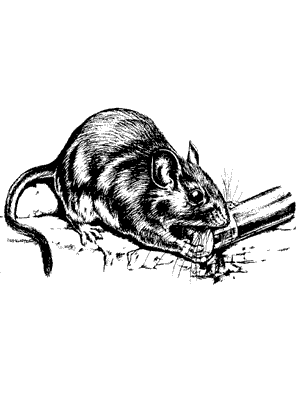 Woodrats Around the Home - March 31, 2010 Jeff Schalau, Associate Agent, Agriculture & Natural Resources University of Arizona Cooperative Extension, Yavapai County If you live on the edge of town or out in the country, then you’ve probably had interactions with woodrats (also known as packrats). The woodrat can be distinguished from other rats by it's fur covered tail and light-colored belly and feet. They are relatively large rodents with large eyes and ears. Three woodrat species can be found in central Arizona: the whitethroat woodrat, Mexican woodrat, and Stephens woodrat. These nocturnal rodents are best known for their attraction to shiny, interesting objects. When they encounter a cartridge casing, coin, soda can tab, or article of jewelry, they will carry it until they encounter another, more interesting object leaving behind the old and departing with the new. This behavior also earned them the names “packrat” and "trade rat." Woodrats are most common in pinyon/juniper, chaparral, and desert scrub plant communities. Their nests are often conspicuous and constructed out of sticks, cactus, and other organic debris. Most often, they are built at the base of a tree or shrub, center of a prickly pear cactus, or small cave. However, they can also build nests in attics, underneath houses or in the engine compartment of seldom-driven cars. These nests can be occupied over many generations and in some cases up to a thousand years. At the center of a woodrat nest is the midden: a central living and food storage area. These middens have accumulated layers of urine and feces. In these layers, paleoecologists study long-term changes in plant communities by identifying pollen types and other plant debris found in the midden. Indigenous peoples have been known to rob their nests in search of pinyon nuts. Last year, I did not have to prune my peach tree because a packrat had done it for me – it did a pretty decent job of it too. Their menu varies from cactus, juniper berries, acorns, and pinyon nuts to leaves, plant shoots, flowers, and fruit. These latter dietary preferences usually introduce urban dwellers to woodrats. Yavapai County Cooperative Extension receives many calls each year about these home and garden invaders. Woodrats are notorious for chewing automotive wiring of parked cars. A few of the woodrat calls in recent memory are: pansy flowers being nipped off every morning and ripe tomatoes being mysteriously transported to odd areas. Woodrats are not legally protected in Arizona, so homeowners can implement control measures without first contacting wildlife officials. Exclusion and barriers are the most effective control methods if woodrats are entering structures. Cracks and openings in buildings, including those at attic level, must be sealed. They may enter structures through a hole or crack as little as ˝ inch. Smooth sheet metal barriers at least two feet tall can be effective at preventing damage in gardens or individual plants. Where significant economic damage is occurring, lethal trapping may be warranted. Rat-sized snap traps can be baited with nuts, bacon rind, peanut butter and oatmeal, raisins, other dried fruit, or biscuits. Live traps will also work but releasing animals in another area is not recommended. Studies have shown that animals released into new areas often die from exposure, predation, or competition with resident animals. Keep in mind that trapping by itself is not a long-term solution. You should remove attractants if at all possible. Destruction of nests may also be necessary depending on proximity to structures and/or the extent of damage being observed. Here, the nest should be soaked with an antibacterial/antiviral disinfectant before disturbing. Hantavirus and other zoonotic diseases can be present in woodrat nests. Never handle dead or dying woodrats with your bare hands – use disposable gloves and wash hands after handling. Finally, it should be said that all native animals (including birds and insects) were here before we were. We should try to be good neighbors and respect their presence whenever possible. Lethal control of woodrats should only be used after non-lethal management methods have been considered. The University of Arizona Cooperative Extension has publications and information on gardening and pest control. If you have other gardening questions, call the Master Gardener line in the Cottonwood office at 646-9113 ext. 14 or E-mail us at cottonwoodmg@yahoo.com and be sure to include your address and phone number. Find past Backyard Gardener columns or submit column ideas at the Backyard Gardener web site: http://cals.arizona.edu/yavapai/anr/hort/byg/. |